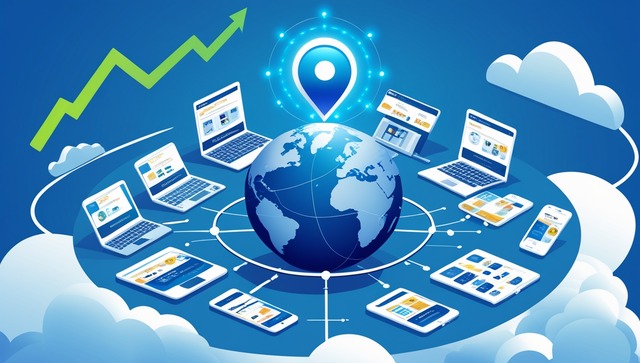Geo marketing, also known as location-based marketing, uses geographic data to tailor advertising efforts. It targets potential customers based on their current or past locations, offering messages that fit the context of where they are or where they’ve been. This method capitalizes on the power of location to deliver relevant content and offers, making campaigns more effective.
The Basics of Geo Marketing
At its core, geo marketing integrates geographic information systems (GIS) with marketing strategies. By leveraging GPS data, IP addresses, Wi-Fi signals, and mobile apps, businesses gain insight into the physical location of their audience. With this information, marketers can send targeted promotions, advertisements, or notifications that align with the customer’s whereabouts.
Imagine a coffee shop sending a discount coupon to someone walking nearby or a retail store alerting shoppers to a flash sale when they enter a mall. These are practical examples of geo marketing services in action. It takes advantage of real-time location data to create timely, relevant messaging.
How Location Data Powers Geo Marketing
Location data comes from several sources, including:
-
GPS on mobile devices: Tracks precise coordinates.
-
Wi-Fi and Bluetooth signals: Helps identify presence within buildings or specific areas.
-
IP addresses: Provide approximate location at a regional or city level.
-
Beacon technology: Enables proximity-based alerts in stores or venues.
Marketers combine these data points with customer behavior, preferences, and past interactions to craft location-specific campaigns. The result is a more direct connection with potential buyers, increasing the chances of engagement and conversion.
Types of Geo Marketing Techniques
Several techniques fall under the umbrella of geo marketing:
Geo-Fencing
Geo-fencing creates a virtual perimeter around a physical location. When a user enters or exits this boundary, the business triggers a notification or advertisement. For example, a clothing store might send a discount message to a customer’s phone the moment they walk into a shopping district.
Geo-Targeting
Geo-targeting focuses on delivering ads to users within a specific geographic area. This method often applies to digital ads, ensuring only audiences from a chosen city, state, or country see the promotion. It helps businesses avoid wasting budget on irrelevant locations.
Geo-Conquesting
Geo-conquesting targets potential customers near competitors’ locations. By advertising to people visiting rival stores, businesses try to lure them away with special offers or incentives.
Location-Based Social Media Ads
Social platforms allow advertisers to focus on users by their location. Facebook, Instagram, and Snapchat let brands select audiences based on cities, neighborhoods, or even precise coordinates. Marketers tailor content to resonate with local culture or events, boosting engagement.
Benefits of Geo Marketing
Geo marketing offers many advantages over traditional advertising methods:
Higher Engagement
Location-based ads tend to capture more attention because they feel timely and relevant. When a message relates to a person’s immediate surroundings, it holds greater value and urgency.
Improved Conversion Rates
Customers who receive offers tied to their location often convert at higher rates. For instance, someone receiving a discount while near a restaurant is more likely to visit than if they see a generic ad elsewhere.
Cost Efficiency
By focusing only on specific areas, businesses avoid spending money on audiences that may never visit their store or use their service. This precise targeting improves the return on ad spend.
Better Customer Experience
Geo marketing helps brands communicate with customers in meaningful ways. Sending relevant offers or information based on location reduces spam and builds trust.
Data-Driven Decisions
Marketers gather insights from location-based campaigns, such as foot traffic patterns and user behavior. These data points guide future marketing strategies and product placements.
Examples of Geo Marketing Success
Several brands have used geo marketing to boost their business:
Starbucks
Starbucks uses geo-fencing to send mobile app users discounts and promotions when they approach a store. This strategy drives foot traffic and increases sales during slow hours.
Walmart
Walmart targets shoppers with digital ads that highlight nearby stores and special deals. By combining geo-targeting with purchase data, Walmart creates personalized campaigns that encourage in-store visits.
Uber
Uber’s app uses location tracking to match drivers with riders nearby. Their marketing messages also reflect local events or weather conditions, encouraging users to request rides when demand peaks.
Local Events
Many event organizers use geo marketing to promote concerts, festivals, or sporting events to people within a certain radius. This method maximizes ticket sales and attendance.
Geo Marketing Tools and Technologies
Businesses use a variety of tools to execute geo marketing campaigns:
-
Google Ads Location Targeting: Allows advertisers to select specific locations for their ads.
-
Facebook Ads Manager: Supports detailed geo-targeting based on user location.
-
Beacon Devices: Small transmitters placed in stores to communicate with nearby smartphones.
-
Mobile Marketing Platforms: Offer geo-fencing, push notifications, and analytics.
-
Location Analytics Software: Helps analyze visitor data and patterns.
These tools make it easy for marketers to design, launch, and measure campaigns based on geographic information.
Challenges and Considerations
While geo marketing has clear benefits, it also presents challenges:
Privacy Concerns
Collecting location data raises privacy issues. Businesses must comply with regulations like GDPR and CCPA and be transparent about data usage.
Accuracy of Location Data
Sometimes location signals can be inaccurate due to GPS errors, signal interference, or outdated IP data. This affects campaign effectiveness.
User Permissions
Many apps require users to grant permission to access location information. If users decline, marketers lose the ability to deliver geo-targeted ads.
Frequency and Relevance
Overusing geo marketing messages can annoy customers. Striking the right balance is key to keeping the audience engaged without feeling spammed.
How Location-Based Advertising Drives Results
Location-based advertising directly impacts business outcomes by connecting with customers at critical moments.
Increasing Foot Traffic
Businesses see more visitors when they send timely offers to nearby consumers. This direct influence drives immediate store visits.
Boosting Sales
Coupons, discounts, or exclusive deals sent based on location encourage purchases. Customers respond well to offers they can use nearby.
Enhancing Brand Awareness
Repeated exposure to geo-targeted ads builds familiarity within local markets. This helps brands establish themselves as neighborhood staples.
Supporting Event Promotion
Events benefit from geo marketing by attracting local attendees. Targeted ads raise awareness among people most likely to attend.
Improving Customer Retention
Engaging customers with location-specific rewards or updates strengthens loyalty and repeat business.
Best Practices for Geo Marketing Campaigns
To maximize the impact of geo marketing, consider the following:
-
Segment Your Audience: Use location data alongside demographics and behavior to tailor messages.
-
Keep Offers Relevant: Provide promotions that align with local culture, weather, or events.
-
Respect Privacy: Be clear about data collection and allow opt-outs.
-
Test and Measure: Track campaign performance and adjust targeting based on results.
-
Avoid Overcommunication: Send messages sparingly to prevent user fatigue.
-
Combine Channels: Use geo marketing alongside email, social media, and traditional ads for greater reach.
The Future of Geo Marketing
As technology evolves, geo marketing will become more precise and interactive. Advances in augmented reality (AR), 5G connectivity, and artificial intelligence (AI) will enable brands to create immersive, location-based experiences.
Wearable devices and smart city infrastructure will offer new data sources and advertising opportunities. Consumers will receive more personalized content that responds instantly to their environment.
Brands that adopt location-based strategies early will gain a competitive edge by connecting with customers more naturally and effectively.
Final Thought
Geo marketing transforms the way businesses connect with customers by using location as a powerful tool. When brands deliver the right message at the right place and time, they create meaningful interactions that drive real results. By focusing efforts on location-based advertising, companies increase engagement, boost sales, and build lasting relationships with their audience. As technology advances, leveraging geo marketing will become essential for staying competitive and relevant in today’s fast-paced market.
- What Is Geo Marketing? How Location-Based Advertising Drives Results
- Discover geo marketing and learn how location-based advertising targets customers effectively to boost engagement, sales, and business growth.
- GeoMarketing, BusinessGrowth, MarketingTips, DigitalAdvertising, MarketingStrategy
Related posts:
 Machinery and Equipment Industry Email List: Unlocking Opportunities for B2B Marketing Success
Machinery and Equipment Industry Email List: Unlocking Opportunities for B2B Marketing Success
 Essentials Hoodie with Bold Logo – A Modern Streetwear Icon for Everyday Style”
Essentials Hoodie with Bold Logo – A Modern Streetwear Icon for Everyday Style”
 Why Investing in Charlotte SEO Is Crucial for Business Growth
Why Investing in Charlotte SEO Is Crucial for Business Growth
 The world of print on demand car wraps and discover how custom car wrap printing transforms vehicles into unique moving canvases.
The world of print on demand car wraps and discover how custom car wrap printing transforms vehicles into unique moving canvases.
 Enhance Your Digital Marketing Strategy with a Data-Driven Digital Marketing Agency
Enhance Your Digital Marketing Strategy with a Data-Driven Digital Marketing Agency
 ways to oversee living where you work ways to oversee living where you work
ways to oversee living where you work ways to oversee living where you work
 Retirement Arranging in Singapore: Retirement Arranging in Singapore:
Retirement Arranging in Singapore: Retirement Arranging in Singapore:
 How to Choose a Web Design Agency in Toronto Keyword: web design agency in toronto
How to Choose a Web Design Agency in Toronto Keyword: web design agency in toronto







